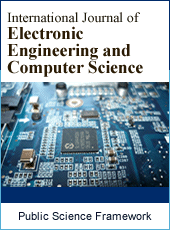International Journal of Electronic Engineering and Computer Science
Articles Information
International Journal of Electronic Engineering and Computer Science, Vol.1, No.1, Aug. 2016, Pub. Date: Jul. 21, 2016
The Study of Machine Translation Aspects Through Constructed Languages
Pages: 28-34 Views: 4509 Downloads: 1405
[01]
Evangelos C. Papakitsos, Department of Education, School of Pedagogical and Technological Education, Iraklio Attikis, Greece.
[02]
Ioannis Giachos, Department of Linguistics, National & Kapodistrian University of Athens, Athens, Greece.
The present paper describes a software system that performs bidirectional machine translation between two constructed languages. These languages are made by one or more persons, for various purposes. Such an important purpose is the development of easy and almost natural communication interfaces with robots. Despite the linguistic simplicity of the constructed languages, the automated translation from one to the other confronts some of the fundamental algorithmic challenges that are also encountered in the machine translation of natural languages. Hence, the usage of constructed languages can be an easier way both to train linguistic engineers in developing machine translation software and to study the linking of different robotic interfaces, as a novel field of research.
Natural Language Understanding, Constructed Language, Machine Translation, Human-Computer Interaction
[01]
Baljinder Kaur & Brahmaleen Kaur Sidhu (2014). Machine Translation: An Analytical Study. International Journal of Engineering Research and Applications, 4(5), Version 7: 168-175.
[02]
Raybaud S., Langlois D. & Smaïli K. (2011). “This sentence is wrong.” Detecting errors in machine-translated sentences. Machine Translation, 25: 1–34.
[03]
Dorr B. J. (1994). Machine Translation Divergences: A Formal Description and Proposed Solution. Computational Linguistics, 20(4): 597-633.
[04]
http://roila.org.
[05]
https://en.wikipedia.org/?title=Constructed_language.
[06]
Giachos I. (2015). Implementation of OMAS-III as a Grammar Formalism for Robotic Applications. Postgraduate Dissertation, National & Kapodistrian University of Athens and National Technical University of Athens, pp. 2-3 (in Greek).
[07]
https://en.wikipedia.org/wiki/Philosophical_language.
[08]
http://en.wikipedia.org/wiki/Toki_Pona.
[09]
https://en.wikipedia.org/wiki/Oligosynthetic_language.
[10]
http://www.laadanlanguage.org.
[11]
http://linguifex.com/wiki/Dama_Diwan.
[12]
https://en.wikipedia.org/wiki/Natural_semantic_metalanguage.
[13]
Wierzbicka A. (1972). Semantic Primitives. Frankfurt: Athenäum.
[14]
Goddard C. (2008). Natural Semantic Metalanguage: The state of the art. In C. Goddard (ed.), Cross-Linguistic Semantics. Amsterdam: John Benjamins, p.33.
[15]
Goddard C. (2010). The Natural Semantic Metalanguage approach. In Bernd Heine and Heiko Narrog (eds.), The Oxford Handbook of Linguistic Analysis. Oxford: Oxford University Press, pp. 459-484.
[16]
http://independent.academia.edu/GiannhsKenanidhs/Teaching-Documents.
[17]
www.unilang.org/blog/SostiMatiko.
[18]
Papakitsos E. (2013). Mini Translator: Software of bidirectional machine translation between the artificial languages of Toki Pona and Minimal Extent Free Greek. Athens: National Library of Greece (in Greek).
[19]
Foxall J. (2009). Visual C# 2008 in 24 Hours: Complete Starter Kit. SAMS Teach Yourself, 2nd Printing. Indianapolis IN: Pearson Education.
[20]
Simova I. & Kordoni V. (2013). Improving English-Bulgarian Statistical Machine Translation by Phrasal Verb Treatment. In J. Monti, R. Mitkov, G. Corpas Pastor & V. Seretan (Eds.), Workshop Proceedings for: Multi-word Units in Machine Translation and Translation Technologies (Organized at the 14th Machine Translation Summit, 2-6 September 2013, Nice, France). Switzerland: The European Association for Machine Translation, p. 64.
[21]
Barreiro A., Monti J., Orliac B. & Batista F. (2013). When Multiwords Go Bad in Machine Translation. In J. Monti, R. Mitkov, G. Corpas Pastor & V. Seretan (Eds.), Workshop Proceedings for: Multi-word Units in Machine Translation and Translation Technologies (Organized at the 14th Machine Translation Summit, 2-6 September 2013, Nice, France). Switzerland: The European Association for Machine Translation, pp. 26-33.
[22]
https://en.wikipedia.org/wiki/Sememe.
[23]
Babiniotis G. (1985). Introduction to Semantics. Athens: G. Gkelbesis, p. 47 (in Greek).
[24]
Giachos I. (2015). Implementation of OMAS-III as a Grammar Formalism for Robotic Applications. Postgraduate Dissertation, National & Kapodistrian University of Athens and National Technical University of Athens, p. 58 (in Greek).
[25]
Bond F., Oepen S., Nichols E., Flickinger D., Velldal E. & Haugereid P. (2011). Deep open-source machine translation. Machine Translation, 25: 87–105.
[26]
Carbonell J. R. & Collina A. M. (1973). Natural semantics in artificial intelligence. In Proceedings of the 3rd International Joint Conference on Artificial Intelligence, San Francisco, CA: Morgan Kaufmann, pp. 344-351.
[27]
Gonzalez M. (2015). Artificial Intelligence Semantics. SDSU Student Research Symposium (SRS), San Diego State University.
[28]
Rapaport W. J. (2013). Meinongian Semantics and Artificial Intelligence. Humana. Mente Journal of Philosophical Studies, 25: 25-52.
[29]
Fellbaum C. (ed.) (1998). Word Net: An Electronic Lexical Database. Cambridge, MA: MIT Press.
[30]
Kornilakis H., Grigoriadou M., Galiotou E. & Papakitsos E. (2003). Aligning, Annotating and Lemmatizing a Corpus for the Validation of Balkan Wordnets. Workshop on Balkan Language Resources and Tools. Thessaloniki, November 2003.
[31]
Abedin Md J. & Purkayastha B. S. (2013). Detection of Multiword from a WordNet is Complex. International Journal of Research in Engineering and Technology, 02 (Special Issue: 02): 89-91.
[32]
Garidis P. K. & Deligiannakis E. N. (1993). Dictionary of Computing (English-Greek / Greek-English). (6th Edition), Athens: diaulos, pp. 481-482.
[33]
Garidis P. K. & Deligiannakis E. N. (1993). Dictionary of Computing (English-Greek / Greek-English). (6th Edition), Athens: diaulos, pp. 106-107.

ISSN Print: Pending
ISSN Online: Pending
Current Issue:
Vol. 6, Issue 3, September Submit a Manuscript Join Editorial Board Join Reviewer Team
ISSN Online: Pending
Current Issue:
Vol. 6, Issue 3, September Submit a Manuscript Join Editorial Board Join Reviewer Team
| About This Journal |
| All Issues |
| Open Access |
| Indexing |
| Payment Information |
| Author Guidelines |
| Review Process |
| Publication Ethics |
| Editorial Board |
| Peer Reviewers |


